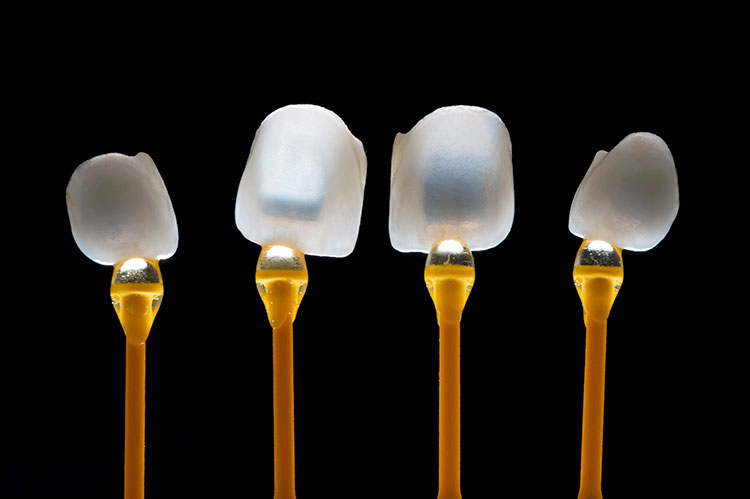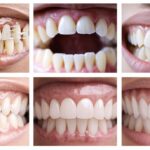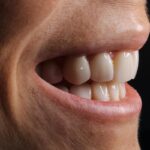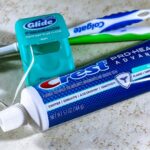The word ‘braces’ tends to make us think of the nerdy kid with a mouth full of metal and headgear resembling an embarrassing crown. Braces are something that most people have considered a trial to be dreaded. Thankfully, braces have advanced so much that the nerdy headgear image is no longer a reality.
In modern dentistry, there is a wealth of options when it comes to adult retainers and braces and most of them are much more aesthetically pleasing than their out-dated counterparts.
What are Braces?
The basic principle of braces is to apply pressure to the teeth to slowly move their position. Traditionally, this involved a system of brackets and a wire that was gradually tightened. Although this system is still used with some modifications, there are also new methods that consist of a barely visible plastic pieces that encase the teeth to apply pressure without relying on wire tightening.
Bracket and wire braces have been the most commonly used. There are three options available: metal, ceramic, and lingual.
Metal braces are the one that earn the nickname “train tracks”. They consist of a metal bracket that is secured to the front of the teeth by a type of strong glue, which gets hardened under a curing light. Unlike the brace of old, the metal brackets of the modern version are significantly smaller and although they are still quite visible, they don’t draw as much attention and are therefor quite suitable as adult braces.
Ceramic braces function in the exact same way that metal braces do. The only difference is that the brackets are made of ceramic and able to blend in with your teeth. The arch wire that runs through the bracket is still visible so these braces aren’t entirely hidden from view, although they’re much more camouflaged than the metal version.
Lingual braces are the same thing as the traditional metal brace with one exception: they placed on the backside of the teeth. These are basically ‘incognito braces’. They can’t be seen when you smile and no one will know they are there. However, there are a couple drawbacks to having brackets and a wire along the back of the teeth. Keeping any form of bracket and wire braces clean can be a chore but with lingual braces, it’s twice as hard. It may also be uncomfortable and affect speech for a short time after they are put on. These are suitable adult braces.
How Much Do Braces Cost?
The cost of the bracket and wire braces varies. Metal and ceramic braces are similar in prices with metal braces costing $3,000 to $8,000 and ceramic braces costing $4,000 to $8,000. Lingual braces are more expensive due to the difficulty of having to work behind the teeth to get them put on and they can cost up to $10,000. For all of these braces, the overall amount of money you pay will be higher in the end because multiple appointments will be needed to tighten the wires and make adjustments.
Most Popular Braces for Adults
For those that do no want to deal with wire adjustments or having metal attached to their teeth, there is another option. Invisible aligners have become more popular over the last decade. Rather than being glued to your teeth, invisible aligners are a plastic tray that is custom fit to your teeth. They are replaced by a new aligner every few months, with each aligner being slightly different to gradually push your teeth into a new position. According to Invisalign, a popular brand of invisible aligners, the cost for these falls into the same range as traditional metal braces. This is the most popular braces option for adults.
What is a Retainer?
As the name suggests, a retainer is an appliance that helps your teeth retain their new alignment after the braces come off. As is the case with braces, retainers comes in both visible and invisible forms.
A Hawley Retainer is the metal wire retainer that most people are familiar with. It is made of a hard plastic piece that sits against the back of the teeth and an archwire that runs along the front of the teeth to prevent them from shifting. This type of retainer is visible but it generally doesn’t need to be worn all the time and can be taken out during times when you’d rather show off your new smile than have people see the retainer. These retainers can be a little pricey and cost up to $340 for each set, with the top and bottom being bought separately. They are also notoriously fragile so repairs or replacements may be needed occasionally.
One of the invisible options is an Essix Retainer. In appearance, an Essix Retainer looks almost identical to an invisible aligner. They are made of clear plastic and are fitted to completely encase your teeth. With a price tag ranging from $100 to $285, they initially look like a cheaper option but that’s a bit deceiving. A plastic retainer can not be repaired and they need to be replaced every 3 to 4 months. Invisalign has a program for their plastic retainer, Vivera®, that has an average annual cost of $500 and includes a replacement retainer every 3-4 months. Over time, an Essix Retainer is actually more costly than the metal Hawley retainer.
The last option for a retainer is a Lingual Retainer, also known as a Bonded Retainer. As with lingual braces, this type of retainer is placed behind the teeth. It is usually referred to as ‘permanent’ because the retainer is bonded, or glued, to the back of the teeth and does not get removed. However, they are not entirely permanent. Chewing can wear down the retainer and the glue, causing the need for it to either be replaced for bonded again. The price for this type of retainer is usually similar to that of an Essix retainer with only a slight increase. Although the idea of a retainer that is not visible, doesn’t come with the risk of getting lost, isn’t overly expensive, and can be forgotten most of the time sounds appealing, a lingual retainer has a few drawbacks. Cleaning the retainer can be very difficult and it may also cause difficulty with properly caring for your teeth because flossing can be a challenge. Due to the position on the back of the teeth, it will present the same problems with comfortability and speech that can occur with lingual braces.
Are Braces and Retainers Painless?
The process of having braces put on is not painful. While it’d be easy to think that getting braces applied is a complicated endeavor, it’s actually quite simple. For wire and bracket braces, the orthodontist visit starts out with your teeth being thoroughly cleaned to make sure there’s nothing on the surface to hinder the glue from sticking. Then, the glue and brackets are carefully applied before a light is used to quickly hardened the glue and solidly secure the brackets in places. Lastly, a wire is run through the brackets and tightened, along with elastic bands being added to apply pressure to specific teeth that need to be moved a little more than the others. In general, the whole process tends to take about an hour although lingual braces can take a little longer due to it being more difficult to efficiently work behind the teeth.
There are very few complaints of pain during the process of getting the braces put on but the days following application or adjustments can be a little less than pleasant for some. Braces put constant pressure on the teeth and that means that the gums are also being affected. Soreness and inflammation is very common for a few days after having braces put on or having the wire tightened during an adjustment because you’re not use to the added pressure right away. Typically, the pain is mild but some people experience more than others. Eating soft foods for the first few days and taking over-the-counter pain medication can help manage any pain that occurs.
Even without pain being present, having your gums bleed a little is also common. It’s a side effect of the inflammation and is nothing to worry about. However, if the bleeding become consistent, you should see your dentist. Frequently bleeding gums is a sign of gingivitis, which occurs more easily in those with bracket and wire braces because flossing and oral care can be more difficult. It is treatable and will require a few changes to your oral care routine, including using special hygiene tools that are designed to work around braces.
For invisible aligners, the process is just as simple. Impressions of your teeth are digitally scanned and then a series of aligners are made with progressive changes. In some cases, the aligner only needs to be slipped on but most of the time, attachment or ‘buttons’ have to be applied to the teeth first. The purpose of an attachment is to make sure that the aligner is putting enough pressure on the correct teeth. They are applied by first placing a type of priming gel on the teeth that will need the attachments. Then a tooth-colored material is placed into a tray called an ‘attachment template’. The template comes custom fit to your teeth with small spaces to allot for the attachments. Once the material is put into the spaces, the template is placed over your teeth and any excess material is removed. A curing light is then used to quickly harden the material and the template is taken off. After all the attachments are in place, the aligner can then be put on.
Since only about 3 attachments can be place at a time, the process can be long but it’s entirely painless and no numbing gels or shots are needed. All braces, even aligners, work by applying constant pressure so the same soreness experienced with wire and bracket braces can be occur with invisible aligners as well. However, aligners can be removed to eat and brush your teeth so the worry of gingivitis and oral care routine challenges isn’t as big of a worry with aligners.
All retainers are utterly painless. Retainers are used after you’re done with braces and your teeth are aligned so by the time you get a retainer, you’ve already gotten past the painful and uncomfortable parts.
Will Braces and Retainers Correct Your Bite?
In most cases, yes. Make sure you go to a skilled and experienced orthodontist.
Aside from surgery, braces are the most effective method of correcting bite issues. All types of braces are effective but wire and bracket braces tend to have better results than invisible aligners, although this may be due to patients removing the aligner more often than they should. Depending on the severity of the bite issue, some surgery may be needed prior to getting the braces put on.
Extractions are common for cases of crooked and overcrowded teeth, allowing the teeth more room to align. The gaps from extraction are almost always closed by the end of the treatment with braces. Issues that stem from uneven jaw length may also require surgery on the jaw because braces will not be 100% effective but this usually only in extremely severe cases where there is a significant issue with the structure of the jaw. More often than not, braces will be more than enough to correct bite issues and straighten out teeth.
While highly effective, braces do a take a long time to work. They may have to be worn for a few years. The constant pressure may feel like a lot when you’re wearing them but it’s actually only a gentle amount and not enough to rapidly move your teeth. New types of wires have sped up the process in recent years, made out of heat activated materials like Nickel Titanium and Beta-Titanium, that are better at keeping the pressure consistent but it’s still not an abrupt result. This method of bite correction does require a lot of patience, effort, and dedication, regardless of whether it’s wire and bracket braces or invisible aligners.
Retainers are an important part of the maintaining the results of using braces. Teeth have a tendency to shift back into their original position, especially in adults, and the bite issues can reoccur. The use of a retainer prevents that and keeps the teeth securely in their new positions. The length of time a retainer is needed varies. It can be only a few years but with adults, it’s often needed for as long as you still have your teeth. They can be removed for eating, brushing, or social engagements, but a consistent use of the retainer is vital to maintaining your new correct bite alignment.
Within a study, Essix Retainers were found to be more effective than Hawley retainers but the difference in results was so slight that it would not be noticeable. Overall, all of the retainer options are similarly effective so the choice in retainer comes down to what you find the most comfortable and convenient.
Key Features of Braces and Retainers:
- Highly effective for bite correction
- Both traditional ‘train track’ metal and invisible versions are available
- Treatment can take years to complete, depending on the severity of the issue
- Mild discomfort can occur due to constant pressure being put on the teeth and gums
- Retainers hinder the teeth from shifting after the braces come off and may have to be worn indefinitely
- Price varies but the cost can range from $3,000 to $10,000 for the braces and $100 to $500 for retainers
Modern Alternatives to Braces and Retainers for Adults
As an adult you may not be looking forward to the idea of having your bite corrected with braces and retainers. When considering social aspects, discomfort, and a lengthy treatment period, then you may find yourself more willing to pay a higher cost to have your bite corrected without braces. There are several non-braces treatments being offered, including JawTrac™ bite correction and instant orthodontics with VENLAY® restorations.
Citations:
Demir, A., Babacan, H., Nalcacı, R., & Topcuoglu, T. (2012). Comparison of retention characteristics of Essix and Hawley retainers. The Korean Journal of Orthodontics, 42(5), 255. doi:10.4041/kjod.2012.42.5.255
How Much Do Braces Cost Without Insurance? (n.d.). Retrieved from https://www.mykoolsmiles.com/content/braces-for-teeth-cost
How much do orthodontic retainers cost? (n.d.). Retrieved from https://www.animated-teeth.com/dental-braces/a-invisalign-dental-retainers.htm
Kuncio, D., Maganzini, A., Shelton, C., & Freeman, K. (2007). Invisalign and Traditional Orthodontic Treatment Postretention Outcomes Compared Using the American Board of Orthodontics Objective Grading System. The Angle Orthodontist, 77(5), 864-869. doi:10.2319/100106-398.1
Rizvi, H., Sikder, M., & Hossain, M. (2013). Orthodontic Treatment of Severe Crowding Malocclusion with Extraction of premolars. Bangladesh Journal of Orthodontics and Dentofacial Orthopedics, 2(2). doi:10.3329/bjodfo.v2i2.16161
Yang, S., DMD. (n.d.). All About Arch Wires. Retrieved from http://www.archwired.com/ArchWires_Dr_Yang.htm
Vivera Clear Retainers. (n.d.). Retrieved from https://www.invisalign.com/how-invisalign-works/vivera-retainers
Weiland, F. J., Bantleon, H., & Droschl, H. (1996). Evaluation of continuous arch and segmented arch leveling techniques in adult patients—a clinical study. American Journal of Orthodontics and Dentofacial Orthopedics, 110(6), 647-652. doi:10.1016/s0889-5406(96)80042-4









